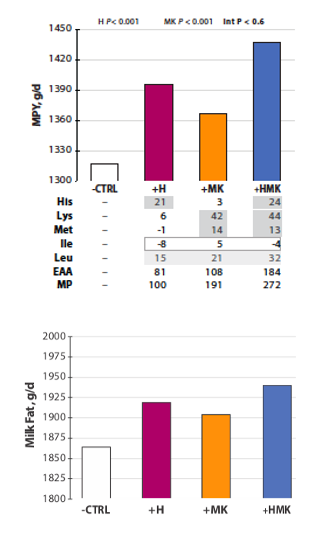Beyond the Barrel: Fully Balanced AA for Milk Protein & Fat
Beyond the Barrel:
Fully Balanced AA for Milk Protein & Fat
By focusing on five essential amino acids, dairy nutritionists can formulate lactation diets to simultaneously optimize both milk protein and milk fat.
Research over the past decade shows that methionine (Met), lysine (Lys), histidine (His), isoleucine (Ile), and leucine (Leu) have independent, additive effects on milk protein yield, as described in NASEM 2021. However, more recent studies also point to specific AA having independent effects on milk fat synthesis.

“We are well beyond the leaky barrel metaphor that typically illustrates methionine as the first limiting amino acid in dairy diets,” says Dr. Sebastian Arriola Apelo of the University of Wisconsin-Madison.
“In addition to Met and Lys, three other essential AA — His, Ile, Leu — provide independent, additive responses for milk protein yield as shown through jugular infusion studies, which contradicts the idea of a first limiting amino acid.
“More recently,” Arriola Apelo points out, “dietary studies have confirmed that in addition to Met and Lys (shown as K in charts), balancing dairy diets for His provides independent, additive increases in milk protein while also having comparable effects on milk fat.”

Furthermore, studies in the Arriola Apelo Lab have shown that production responses to balanced AA supplementation can be maximized in low (21%) starch diets.
Arriola Apelo cautions that pushing energy into lactation diets for high producing dairy cows through rumen fermentable starch can increase the risk of rumen acidosis and depress milk fat production. In addition, increased propionate supply to the cow — the main product of starch fermentation and the substrate for glucose synthesis — increases insulin concentration in plasma. During post-peak lactation, higher insulin can partition nutrients away from milk and towards body reserves, reducing feed efficiency during the current lactation and increasing the risk of over-conditioning and transition health problems in the following lactation.
Fortunately, Arriola Apelo notes, low-starch diets with highly-fermentable non-pNDF content can improve milk output, including protein and fat concentration, while reducing nitrogen emission, particularly at post-absorptive levels.
“While insulin plays a critical role in milk protein synthesis regulation,” he adds, “the mammary glands have the plasticity to use different energy sources. And, with balanced AA supplementation, the cow can make the best use of dietary nitrogen, putting more into milk and less into urine and feces.”
Questions?
Email FeedInsight 4Dairy

